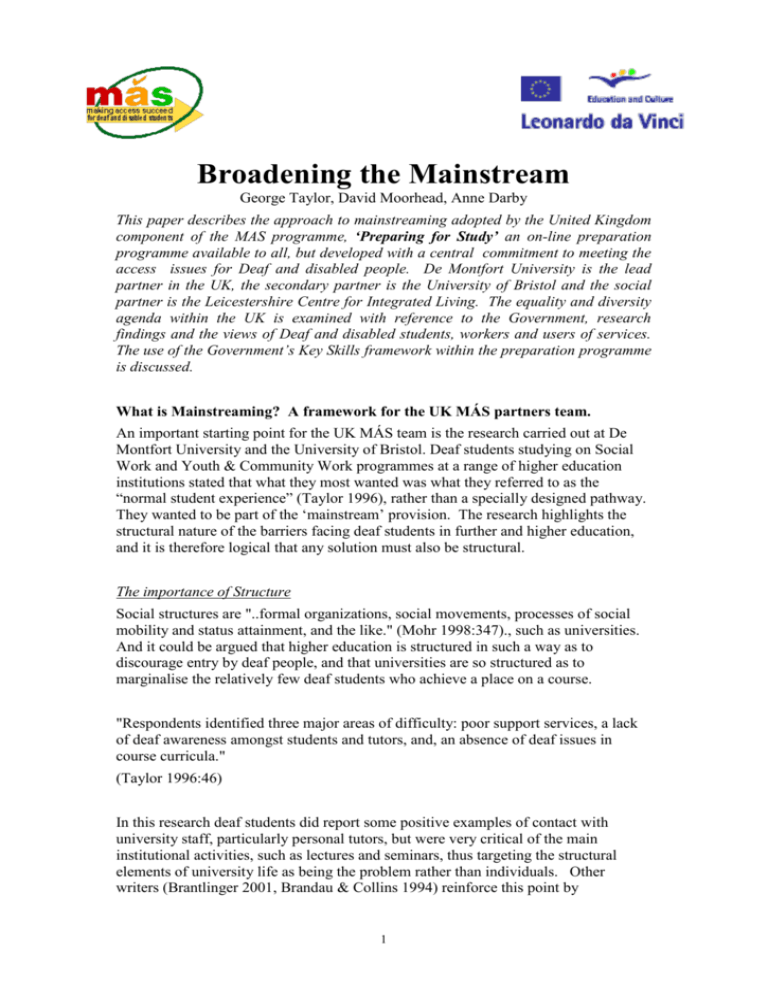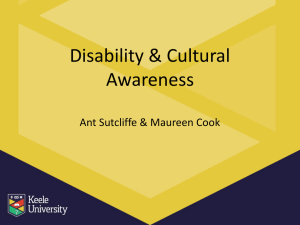Word document
advertisement

Broadening the Mainstream George Taylor, David Moorhead, Anne Darby This paper describes the approach to mainstreaming adopted by the United Kingdom component of the MAS programme, ‘Preparing for Study’ an on-line preparation programme available to all, but developed with a central commitment to meeting the access issues for Deaf and disabled people. De Montfort University is the lead partner in the UK, the secondary partner is the University of Bristol and the social partner is the Leicestershire Centre for Integrated Living. The equality and diversity agenda within the UK is examined with reference to the Government, research findings and the views of Deaf and disabled students, workers and users of services. The use of the Government’s Key Skills framework within the preparation programme is discussed. What is Mainstreaming? A framework for the UK MÁS partners team. An important starting point for the UK MÁS team is the research carried out at De Montfort University and the University of Bristol. Deaf students studying on Social Work and Youth & Community Work programmes at a range of higher education institutions stated that what they most wanted was what they referred to as the “normal student experience” (Taylor 1996), rather than a specially designed pathway. They wanted to be part of the ‘mainstream’ provision. The research highlights the structural nature of the barriers facing deaf students in further and higher education, and it is therefore logical that any solution must also be structural. The importance of Structure Social structures are "..formal organizations, social movements, processes of social mobility and status attainment, and the like." (Mohr 1998:347)., such as universities. And it could be argued that higher education is structured in such a way as to discourage entry by deaf people, and that universities are so structured as to marginalise the relatively few deaf students who achieve a place on a course. "Respondents identified three major areas of difficulty: poor support services, a lack of deaf awareness amongst students and tutors, and, an absence of deaf issues in course curricula." (Taylor 1996:46) In this research deaf students did report some positive examples of contact with university staff, particularly personal tutors, but were very critical of the main institutional activities, such as lectures and seminars, thus targeting the structural elements of university life as being the problem rather than individuals. Other writers (Brantlinger 2001, Brandau & Collins 1994) reinforce this point by 1 highlighting the competitive structure of education as a disincentive to achievement for marginalised groups, and point to formal structures as the problem: "Legislators pass regulations, and professionals develop policy and guidelines for practice. Official sanctions such as these solidify the legitimacy of the symbolic violence of hierarchy relations......Hierarchy establishment is depersonalised; school personnel simply follow mandates or adhere to guidelines. Power relations are disguised as they are perpetuated." (Brantlinger 2001) Deaf students were similarly critical of the other main features of their university experience; recruitment, admissions and assessment systems; classrooms, the library and the refectory; and social and leisure space. All of which were designed in such a way that makes it difficult for deaf people to achieve, or even participate. This issue is further explored in a follow-up research project (Taylor & Palfreman-Kay 2000) which focused on an examination of the relationships between students on Access to Higher Education programmes. This research also included dyslexic students, as well as deaf students. Relationships between students, it is argued, are an integral component of the university experience, whether they occur in formal or informal teaching arenas or leisure spaces, and are therefore to be considered as structural events. The research reported clear differences between the nature of the relationships that deaf students had with non-disabled students to those that dyslexic students had with their non-disabled peers, particularly in the area of informal support where non-disabled students demonstrated high levels of empathy for the problems faced by dyslexic students. The data provide a pointer to the impact of structural forces as an explanation: "A major factor, we would argue, in the relationship between disabled and nondisabled students is the previous relative lack of contact between the two groups, particularly during primary and secondary education. Attitudes about difference and disability are formed and reinforced through early life experiences, and this is precisely the period when disabled and non-disabled children are segregated from each other. A form of educational apartheid exists (Leicester & Lovell 1997), and is clearly an encouragement to the negative stereotypes towards disability that have developed in society." (Taylor & Palfreman-Kay 2000:49-50) The development of the on-line ‘Preparing for Study’ Programme by the UK MÁS team is a response to the difficulties articulated by deaf students. A UK national context. Three elements in the UK context that may help us to understand mainstreaming in relation to this project are: The impact of the extension of the Disability Discrimination Act 1995 to include education and training 2 The promotion of Key skills throughout the education and training system The government's Diversity and Equality agenda and its links to EU social policy The Special Educational Needs and Disability Act 2001 extended anti-discrimination legislation to education and training. A key principle in the original Act is that disabled people should not be discriminated against in the provision of the kinds of goods and services that were available to all. While there are many who feel that the Disability Discrimination Act does not go far enough in promoting the right to equal access and participation, the principle remains that disabled people have access to the same range of services that are available to any other person, and that reasonable adjustments are made to enable this to happen. In relation to education, it is clear that education and training providers will be expected to adjust the way they put together their curriculum and programmes as well as the way they teach, in order to do this. This challenges providers to think about inclusive education and training, a somewhat difficult task for some in higher education, which has been characterised in the past by exclusion and elitism. Key skills are those generic skills that can help an individual to improve their own learning and performance in education, training, work and life in general. The national key skills framework comprises six areas: application of number - interpreting information to do with numbers, doing calculations and presenting findings communication - speaking and listening, reading and writing information technology - using a computer to find, explore, develop and present information, including text, numbers and images improving own learning and performance - managing personal, learning and career development problem solving - recognising problems and finding solutions working with others - working with others when planning and carrying out activities in order to achieve shared objectives This framework is at the centre of the government's plans to develop primary, secondary and tertiary education in the UK, and in the promotion of life-long learning. It is also central to the development of the key skills format in a panEuropean framework, and the government's attempts to integrate national UK educational policy with that of Europe. The UK government now has a clear published vision for diversity and equality: “The government’s vision is of an equal, inclusive society where everyone is treated with respect and where there is opportunity for all. Everyone must be able to play their full part in social and economic life. We need to tackle barriers to participation and change culture so that equal opportunities and equal treatment become a priority for all.” (Diversity and Equality: Making It Happen, HMSO 2002) 3 It is trying to integrate these ideals into all areas of its own work, and to set up the institutional structures to support equality. Central to these plans is the creation of a single equalities body to support equality legislation. At one level, this places the disability agenda in to the mainstream, yet at another there are concerns that disabled people's rights may be marginalized within a single organisation where other interests have more powerful and well-established voices. As referred to above, the aim for the UK MAS team was to respond to the students’ quest for a ‘mainstream’ experience rather than a specially designed pathway whilst remaining alert to the concern that disabled people’s needs may be marginalised as illustrated by personal and professional accounts of mainstreaming (Taylor and Darby 2003, City of Nottingham 2002) which demonstrate that the experience for most Deaf and disabled students is of assimilation rather than inclusion. Comparative numbers for University students suggest that there are particular access issues for Deaf and disabled students. De Montfort University had for a number of years run a workshop based preparation programme for local people seeking to apply to the social work course but who did not, at the time of application, meet the criteria for admission. We decided to apply the social model of disability to this programme, aim to remove barriers to study and provide a model that other University course teams could adopt and adapt. Experience within the Deaf community and contacts within the disability movement, particularly with the Shropshire Disability Consortium led us to respond to Deaf and disabled users of social services demands for appropriate models of services in which Deaf and disabled professionals were working to deliver culturally matched services (Wright & Craddock,1991). Allied to this, our experience led us to be aware of Deaf people working in education, voluntary organisations and the personal social services who are highly skilled, but on low salary grades because they lack professional qualifications. While the preparation programme had been successful in attracting numbers of students from minority groups, it had not recruited Deaf and disabled people. We therefore decided to develop a version of the workshop programme so that it would run on-line, enabling disabled students to work either from home or from an accessible venue where there would be peer support from other disabled people. As for the workshop based route, the on-line programme had two equal elements: it uses the national Key Skills framework as adapted by the University and it has a coursespecific element. It was important to us that the material was developed by disabled people, took a social model perspective and was available to anyone who wished to use it. As well as the content of the material being appropriate to disabled people, we also hoped that an evaluation by Deaf testers of the material would tell us where the barriers lay in terms of accessibility to the language content of the material. The course-specific material we have control over, as would any other course offering this type of programme in the future, and our partners at the Leicestershire Centre for Inclusive Living were able to give constructive feedback to the university department running the Key Skills programme to enable the appropriate changes to be made with the next revision of the programme. We hope to develop a cohort of Deaf and disabled students who, having completed the preparation programme, would then move onto the social work course as a group, studying alongside non-disabled students who were already familiar with some of the issues posed by deafness and disability. 4








